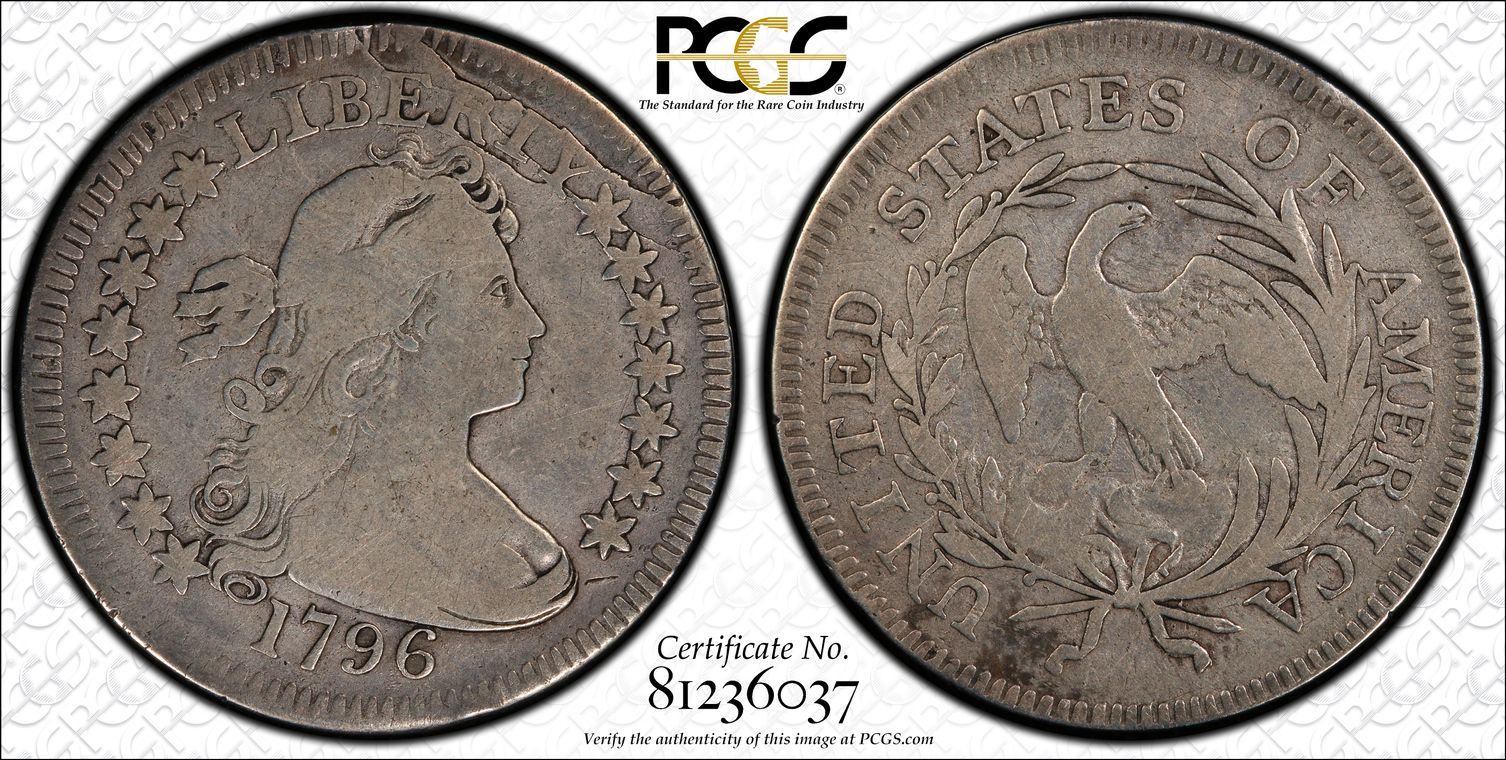1796 25C Browning 2 VG8 认证号81236037, PCGS号38920
专家评论
Ron Guth
This was the only use of the obverse die.
The reverse die of this variety was also used on:
1796 Browning 1
The easiest way to tell the two 1796 obverses apart is by comparing the relationship of the E and the R of LIBERTY to the hair curls
The following is reprinted with permission from “The Early Quarter Dollars of the United States 1796-1838” by A.W. Browning, completely updated by Walter Breen, copyright 1992 by Bowers and Merena Galleries, Inc.:
1796 Browning 1
Obverse: Date not equally spaced , 7 and 9 too close, 6 is low, about twice as far below bust as in No. 2. In LIBERTY, T and Y touch at top. Lower right star almost touches drapery.
Reverse: Seven berries on laurel branch, one leaf of laurel touches D in UNITED. The lily touches A, R and A in AMERICA.
Obverse die perfect; reverse perfect in early impressions, later pieces show a weakness at the eagle’s head. Specimen coins or Proofs, were apparently struck from this reverse with both obverses, but sharp, perfect impressions of the reverse are found only in this variety, which is very rare.
Date spaced 1 79 6, the 6 low; curl point under center of B.
Browning-1; Clapp-2; Duphorne-1; Breen-3881; Haseltine-2; Hilt 2.
Rarity 6
Dies by Robert Scot and John Smith Gardner, after designs by Gilbert Stuart and John Eckstein. Stuart finished a drawing (now lost) portraying Philadelphia socialite Mrs. William Bingham (nee Ann Willing), in Newport, RI, about August 1795; this was intended for the new dollars to be coined in October 1795. (AJN 21:95 [April 1887]). “The head of Liberty, on the dollar of 1795, was designed by Stuart, the celebrated portrait painter, at the request of the Director [Henry William DeSaussure], as we learn from a relation of the family; Stuart facetiously remarking that ‘Liberty on the other coins has run mad’ – referring to the disheveled hair on the head of Liberty on the previous coins –‘ we will bind it up, and thus render her a steady matron’.” (J.R. Snowden, Washington and National Medals, Philadelphia: Lippincott, 1861, p. 177; quotation marks supplied for clarity.)
The dies must have been completed before Gardner left the Mint, April 1, 1796. Hilt guesses that about 25 survive, = 1.32% of the original mintage, which he estimates at 1,900 and derives from the June 12, 1804 delivery (p. 106) – a conclusion unsupported by his statistics. He also estimates that 7.0% of the survivors should be Uncirculated, i.e. about two specimens (p. 108); [but] there are more than that [in the Condition Census]!
Numerical Condition Census (RWM, Sr. [circa 1992]): 62PL, 60PL, 60, 60, 55+, 55PL (4).
PCGS #
38920
设计师
Robert Scot
边缘
Reeded
直径
27.50 毫米
重量
6.74 克
铸币数量
6146
金属成分
89.2% Silver, 10.8% Copper
更高评级数量
9
评级较低的钱币数量
6
地区
The United States of America
价格指南
PCGS 数量报告
拍卖 - PCGS 评级的
拍卖 - NGC 评级的






















